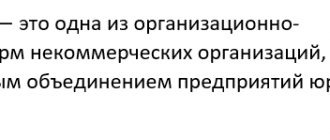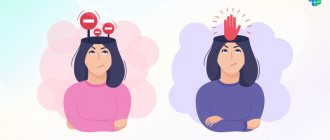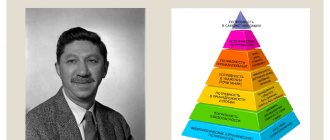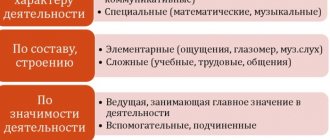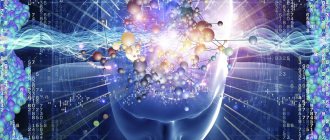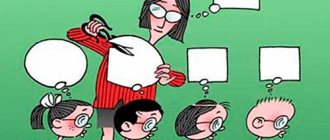The famous Italian writer Gianni Rodari, using a romantic comparison, showed how the association is formed. He compared the spoken word to a stone thrown into a river. The stone made waves on the water, which made everything in it sway: a leaf, a reed, a water lily, a fishing rod float. Only waves from the spoken word arise in our cerebral cortex; what you hear evokes images, memories, thoughts.
Translation of creativity
- creativity
social creativity - social creativity- creative, creative work, creativity
- oeuvre
- creative
creativity of writers - creative writers— creative
- work
scientific creativity- Job
- art
folk art - folk art- art
- creation
artistic creativity- creation
- creative activity
- creative activity
- Werk
- work - Werke
- Schaffen
- work - Schöpfertum
- Kunstschaffen
- artistic creativity - Oeuvre
- creative heritage
- creation
contemporary creativity- work, creation
- art
- art - effort creator
What is creativity (adjectives)?
Selection of adjectives for words based on the Russian language.
folk literary artistic oral poetic own early free collective joint scientific children's all pure present musical any late historical technical authentic true living criminal religious further original verbal individual personal song inspired spiritual human composer oral similar subsequent visual mature independent spontaneous writer stranger linear original social independent impossible exceptional related fantastic other ingenious none rich written multifaceted cultural executive state Russian amateur original
What can creativity do? What can you do with creativity (verbs)?
Selection of verbs for words based on the Russian language.
render receive have cause like appear perceive perceived bring out exposed remain shift bring bring leak promote turn out have to give remain develop develop carry conclude continue to flourish have to form help serve differ mix lose capture become help go define study create lay consist mark reduce arise arise reflect abound compose absorb come count count appear build pour out act dry up precede attract call put appear blossom express prepare enter turn back
Associations to the word creativity
wholeareacurseparticularfailureyearknowledgepointsearchbasisextensionsidestyledegreecomparisonlifelifecraftlawtraditionplagiarismspherearthelpfootballendwestremakecinemafurnishingsoceaninventionbypassfeaturesciencegenreemigrationcrisisviewworldconditionsinvolvementtheaterschoollabichprocessworkaltaardinessdescriptionmassarussiacriterionmoldavian republiclevelcollegemeasuremomentministergiveneratitleauthorknowledge
Psychodiagnostic methods using associations
Types of conflicts in psychology and ways to resolve them.
Since the beginning of the 20th century, connections spontaneously arising in the cerebral cortex have been used by psychologists to diagnose human mental states.
S. Freud was the first to draw attention to the connection between free associations and processes occurring at the level of the unconscious.
According to his theory, at this deep level of the psyche there are instincts and desires suppressed by a person, which contradict the requirements of society.
But having driven these forbidden desires into the far corner of the unconscious, a person did not get rid of them. They continue to influence his behavior, provoke phobias or strange behavior, and even cause mental disorders and organic diseases.
Free association method
Associations that arise involuntarily carry information about these suppressed desires and instincts, which allows a psychologist or psychiatrist to make a diagnosis. For this, S. Freud developed and began to use the method of free association, which to this day is one of the main ones in psychoanalysis.
The principle of this method is very simple. Having assumed a comfortable position and relaxed, the patient should simply say whatever comes to his mind. He can talk about his problems, or he can simply reflect on the meaning of life or discuss his colleagues. You need not to control, not to analyze, not to choose the right words, but to speak freely.
The patient’s thoughts and words themselves evoke different associations in his mind, generating a new stream of speech activity and pulling out from the unconscious what is hidden there and interferes with life. But the psychoanalyst must recognize the connection between individual phrases, words, and reservations of the patient and his psychological problems and complexes, identify these problems and reveal their essence to the client.
Variety of association methods
Currently, associative thinking is used in many psychodiagnostic techniques that make it possible to study the characteristics of an individual’s mental state, his problems, experiences and attitude towards others. Unlike Freud and his followers, representatives of other psychological movements prefer to use not free associations, but more organized and controlled by a psychotherapist. The methods are developed in such a way as to not only stimulate the emergence of associations, but also to be able to statistically process the results and compare them with data from other clients. All such diagnostic methods can be divided into three groups of tests:
- Based on verbal associations. In such tests, subjects are presented with a series of words or phrases, in response to which they must say the first thing that comes to mind. The very formulation, meaning, and scope of use of phrases are designed to reveal the internal problems of the person being diagnosed. One of the most popular such techniques is the “Paired Associations” test.
- Based on visual associations. Looking at the proposed pictures, often abstract, the client must say what they remind him of. The most famous of these techniques are the Rorschach Ink Blot Test and metaphorical cards.
- Based on the analysis of creative products. In order to study unconscious associations, the diagnosed person is asked to complete a creative task, for example, write an essay on a given topic or draw something. The creative process frees thinking and connects the subconscious to the process, which facilitates the birth of associations and opens access to archetype images, hidden desires and poorly understood problems.
Associative thinking is not only a source of important information about a person, it is a necessary condition for the intellectual and creative development of the individual
Personal connection tools
Associations are based on conditioned reflex reactions. Each external stimulus causes the appearance of a focus of excitation in the cerebral hemispheres of the cerebral cortex.
These factors are:
More than 9,000 people have gotten rid of their psychological problems using this technique.
- smells;
- words;
- sounds;
- tactile sensations;
- thoughts.
In the lesion, an electrical impulse passes through the neurons, which spreads across areas of the cerebral cortex. During this period, traces of previous passages of the impulse are activated and images that arose earlier upon contact with the object are recalled from memory.
The process of creating associations is necessary for the normal functioning of consciousness and increasing the efficiency of thinking, and is regulated by several tools:
- Memory and the information stored in it. Strengthening memory and expanding horizons create the opportunity for more quality associations to emerge. The result is the development of diverse and new connections.
- Imagination , which processes information, changes and combines combinations of elements in new forms of images. The work of imagination enriches a person’s memory; the resulting associations are used in thinking.
- The speed of passage of a nerve impulse or the occurrence of nervous processes, which regulates the speed of reflex reactions. Greater speed forces the brain to quickly create associations, the variety of which depends on the person’s level of knowledge.
- Unconscious . The process of creating connections is based on the sudden spread of excitation deep into the cerebral cortex and connects the subconscious to thinking. Due to the fact that a large amount of information is stored in this area of perception, associations are an opportunity to interact with the unconscious.
The set of associations is individual for each person, as it is created under the influence of the individual’s experience and knowledge.
Definition
What is an association
Binary operation ∗ on the set S
is associative when this diagram commutes.
That is, when two paths from
S ×
S
×
S
to
S
Sotrose
to the same function from
S
×
S
×
S
to
S.
Formally, the binary operation ∗ on the set S
is called
associative
if it satisfies
the associative law
:
( X
*
y
) *
z
=
x
* (
y
*
z
) for all
x
,
y
,
z
in
S.
Here * is used to replace the operation symbol, which can be any symbol, and even no symbol (matching), as for multiplication.
(
X
)
z
=
x
(
yy
) =
xy for
all
x
,
y
,
z
in
S.
The association law can also be expressed in functional notation as follows: f
(
f
(
x
,
y
),
z
) =
f
(
x
,
f
(
y
,
z
)) .
Types of associations in psychology
Motive: what is it in psychology. system and types of motives
The human psyche has enormous associative capabilities.
Associations are distinguished by type of education:
- by similarity;
- by contrast;
- by contiguity in space or time;
- cause-and-effect associations.
Any learning or memorization of something involves the establishment of appropriate associations or neural connections. Association is nothing more than a “continuous sensation”, like any purely visual or auditory sensation, only it lasts longer, and the character is constantly changing, I.M. believed. Sechenov.
The physiological basis of associations provides a clear picture of the physiological mechanisms of both the process of memorization and reproduction. For example, you need to remember several gymnastic exercises performed sequentially. Connections are established between individual elements of the exercise - these are associations by contiguity. Performing one element triggers the action of nervous processes associated with performing the next element and, as a result, the entire exercise is performed consistently and without errors. When memorizing verbal material, for example, a poem, associations by contiguity are also used.
Associations by similarity are of a slightly different nature, and a person deals with them when the perception of an object evokes in memory the memory of an object similar to it, moreover, this object was never perceived next to the first one.
The similarity of neural connections is the basis of similarity associations, and they are caused by two similar objects. Similar moments cause similar neural connections, which reflect common features in both objects. In the cerebral cortex of connections, excitement arises related to one subject, and naturally causes the revival of connections related to another subject. This type of association is of great importance in the educational process, because it makes it possible to compare the studied phenomena with those being studied, find common features and, thus, better remember the material.
Close to associations by similarity in form are associations by contrast. The essence of this type of association is that the perception of an object evokes a memory of another object that has opposite characteristics. These associations are temporary connections that involve ideas about contrasting objects. These objects are opposite in character and significance of individual members, but are included in a common whole. These objects in practical activities are usually juxtaposed and compared, forming corresponding neural connections.
The laws of association for all memory processes are of great importance and can be found in any of these processes. For better assimilation of educational material, associations are formed deliberately. All of them are of a conditioned reflex nature, and their physiological basis is the closure function of the cerebral cortex. Their occurrence and course are subject to the basic laws of the formation of conditioned reflexes.
In order for the necessary associations to be quickly and accurately formed, it is necessary:
- correctly combine irritations;
- To consolidate a new connection, carry out a sufficient number of repetitions, relying on established and secured connections.
Namespace
There are well-established connections that are inherent in society and the linguistic environment. These images include the name space. Most of the modern names have ancient origins and are therefore associated with their original meaning.
In national cultures, names are often associated with a certain character trait (or appearance).
An example in Russian culture is the name Catherine; the word, due to the historical characteristics of the country’s development, receives a connection with “great” and with the original meaning “immaculate.”
The perception of the estate is influenced by its famous bearers. A famous example of an association in space named after Louis “the Sun” XIV is the French king. The rulers of the dynasty received this name over several centuries. Because of this, when many people mention the name, they associate it with royal attributes, Paris, France.
Many cultures have their own list of “unlucky names.” For example, these are the names of Christian martyrs - Tatyana, Fedor (although this tradition was not very widespread in Rus'). Such lists create negative associations that can spread and strengthen, deliberately predetermining the negative connotation of emerging connections.
A name space is a conditional set of generally accepted associations that can be positive or negative. This area is influenced by known bearers of a particular name.
What are association phrases and how do they help search engine users?
Association phrases are shown in a list at the very bottom: under the search results in the “Together with ... often searched” block. They show what else other users are interested in when they enter the same query.
The block contains up to 10 variants of association phrases (the list does not change when moving to other pages)
The block is located at the very bottom and is intended for those who did not find anything suitable in the search results. This may happen if the request is formulated incorrectly or inaccurately; the user does not understand well what exactly to look for on a topic; there is no quality answer to this request.
The main task of a search engine is to find information, therefore, if contextual advertising and natural search results are not suitable, Yandex and Google suggest trying other queries.
Most read
- Day
- A week
- Month
- 10 signs that you won’t make a good programmer +64 73.7k 231 111
- I spent $40k and ruined a great startup idea +101 42.9k 146 101
- The dean of BSUIR went to work as a junior at an IT company +96 35.9k 17 75
- Transferring Quake 3 to Rust +95 22.2k 57 29
- The main disadvantages of working from home +28 20.7k 78 103
- How I almost threw 150k down the drain or the history of installing fresh air ventilation in an apartment +351 108k 865 513
- 10 signs that you won’t make a good programmer +64 73.7k 231 111
- Propaganda of a totalitarian regime, anti-Semitism and homophobia in a programming textbook in 2022? — It's possible +175 68.1k 83 180
- I was the head of international relations at Google. That's why I left +91 55.7k 127 101
- Ventilation with recovery in the apartment. Without air ducts and SMS +145 51.9k 436 192
- The Nginx office was searched. Kopeiko: “Nginx was developed by Sysoev independently” +791 293k 285 1489
- Chronicle of the confrontation between Rambler and Nginx (updated December 23, at 12:00) +198 145k 77 262
- What does the Rambler Group's attack on Nginx and its founders mean and how will this affect the online industry +423 131k 101 525
- 23 minutes. Justification for slow-witted people +341 125k 511 323
- How I almost threw 150k down the drain or the history of installing fresh air ventilation in an apartment +351 108k 865 513
How to collect association phrases quickly and inexpensively
If there are several dozen initial search queries, then it will be easy to copy the resulting association phrases manually: from the browser to Excel. If there are hundreds, thousands and tens of thousands of them, you cannot do without automation.
In this case, the optimal solution is the association phrase parser from Click.ru, which:
- allows you to collect Yandex and Google keys almost instantly;
- works in the cloud, takes into account the regionality of requests;
- does not require captcha and special fake accounts for parsing;
- costs 3–5 times less than similar tools from competitors.
Moreover, you don’t have to pay anything right away: when registering with Click.ru, the user receives a gift - 50 TK. One TK is a collection of association phrases in 1 search engine in 1 region for 1 initial request.
Step-by-step instructions for using the parser for specialists:
- Register with Click.ru and go to the parser page.
- Upload a list of search queries for which you need to collect association phrases, in XLSX format or just a list.
Attention: the system reads only the first sheet of the Excel table and does this according to the “1 cell – 1 key” principle. There shouldn't be any additional information there.
Process of loading requests for parsing
3. Select a search engine and region. If you primarily work for Western markets, Kazakhstan and Ukraine, it is not necessary to collect phrases from Yandex.
Selecting a search engine and region
4. Run the scan.
The finished report can be studied directly in the browser or pre-downloaded in Excel format. In the future, the file will be available at any time; nothing will be deleted.
Advice: to save money and time on parsing and cleaning the collected semantics, you should not load absolutely all queries from the existing semantic core. If the user's intent does not change, search engines return the same or similar results.
In this example, nothing changes for Yandex: the main thing is that “gasoline lawn mowers”
In addition to the association phrase parser, the Click.ru service offers contextual advertising specialists a set of other useful tools. These are a free media planner, ad generator, auto bidder, etc., as well as a reward of up to 8% of the amount spent on Yandex.Direct and Google Ads. SMM specialists will be interested in the free parser of VKontakte groups, communities and audiences, as well as a bonus for conducting targeted advertising - up to 35% of turnover.
Plant composition
Aloe juice has medicinal properties; chronic eye diseases are treated with it. Regular use improves visual acuity, eliminates swelling and relieves inflammation. Aloe extract is rich in:
- beta-carotene;
- B vitamins;
- choline;
- folic acid;
- vitamin A;
- magnesium;
- chrome;
- zinc;
- potassium;
- calcium
The interaction of these components improves metabolism in the lens, protects it from clouding, which prevents the appearance of cataracts. Aloe juice is an excellent alternative to ophthalmic products. It is dropped into the eyes, lotions and compresses are made from it, and used as an ointment. For example, for conjunctivitis, aloe drops are used for the eyes. An extract or solution that is diluted with water is suitable.
The plant is used for the delicate skin around the eyes. It provides gentle care for the skin. Cosmetologists use the plant to lengthen eyelashes. To do this, the juice is mixed with vegetable oil.
Error correction
The copywriter's main assistant is a tool for checking errors. Before sending the work to the customer, I advise you to run it through one of the following proven services. Otherwise, you can get a bunch of modifications and unpleasant comments from the client. Why do you need it?!
But it is impossible to find all errors using online services. If you want to write really well and at an expensive price, I advise you to take copywriting courses for beginners and professionals.
- Spelling
- Yandex.Speller
- Text.ru
- Gramota.ru
- LanguageTool
- Hemingway Editor
- Grammarly
What it is?
Neurophysiology notes that the process of information perception begins from the moment it affects the receptors. External stimuli are converted into bioelectric energy. Neural networks caused by complex chemical processes allow a person to retain an image in memory for a long time without quantitative or qualitative losses. Thus, the physiological basis of the association is considered to be a short-term neural connection caused by conditioned reflexes.
In psychology, associativity is considered the connecting link between mental phenomena. The structure of human memory is designed in such a way that some memories can generate images associated with them. A person has the opportunity throughout his life to accumulate, retain, preserve, recognize and reproduce a huge amount of knowledge and skills, various ideas and images.
Human memory is associative. Memories entail certain life moments in the form of a logical chain of related events. A few bars of music can evoke a wide variety of feelings. After hearing a fragment of a work, an individual can instantly remember a landscape, a scent, a sound, or a loved one. Associations are a kind of invisible hooks retrieved from the depths of memory. They contain ideas about accumulated life experiences and lived moments that are directly related to what needs to be remembered.
Primitive people used objects to remember. For example, they took with them a pebble or a leaf from a tree. The expression “knot for memory” still remains, meaning a kind of encoding of information. External means of memory come to the aid of its internal process. A tied knot on a handkerchief is a coded image of association.
The theory of associative memory is based on the concept of associations, which are represented by 3 groups.
- Contiguity associations involve the emergence of memories experienced at a certain point in life. For example, having met a childhood friend, a person may remember several episodes from his school days. Memories can evoke positive or negative emotions.
- Associations by similarity mean the identified similarities of a new image that has appeared with a previously encountered human face.
- Associations by contrast can evoke in the mind opposite images that have already been perceived before: “beautiful” - “scary”, “evil” - “kind”, “sweet” - “bitter”, “soft” - “hard”.
The associative system of memorizing concepts is based on simplicity, unusualness and detail. No mental effort is required to create an association. This is a creative process. A technique based on associativity is included in the structure of many techniques. Their implementation allows you to remember a large amount of very complex and serious information.
The connection between human capabilities and the development of certain associative zones
It is known that the behavior of a person with developed frontal zones against the background of underdeveloped others will be determined by the norms of traditional values and morality learned in childhood. That is, if such a person finds a wallet on the street, he will make every effort to return it to the owner, since in childhood he was taught that the found thing must be returned. In addition, the high degree of development of these zones implies great achievements in the natural sciences.
A person with developed temporo-occipital zones mainly does what is beneficial to himself. For example, he can become an ideal corrupt official, suffering absolutely no remorse.
A developed parietal zone in a person indicates the ability to choose the right solution to a problem, and the larger it is, the more accurate the solution. This can be demonstrated by the example of a dispute between two scientists with large parietal zones. As a result, someone who has additionally developed temporo-occipital zones will provide a greater number of convincing arguments.
This theory is based on the anatomical structure of the body, and not on statistical data or external impressions. Thanks to it, there is no need for tedious tests to assess a person’s mental state and abilities. A person’s parameters speak about his emotionality, character, and mental capabilities.
Other large organizations
There are thousands of different associations in the world, but some of them are worthy of special attention, since their activities affect not only individual countries, but also the state of the entire world as a whole.
The following deserve special attention:
Association of Southeast Asian Nations (ASEAN).
It is a regional organization that was created to increase economic growth, improve social conditions and cultural development. ASEAN includes countries such as Indonesia, Thailand, Singapore, the Philippines, etc.
World Health Organization (WHO).
This medical association is a special agency of the UN. The goal of WHO is to help the people of the world achieve the best level of health, fight epidemics, eliminate dangerous diseases, and control the quality of medicines. This association is very important for the whole world. This is truly a big step forward and good support for both developing and developed countries.
UNESCO.
This association is designed to maintain peace, stability and security through cooperation between states in the fields of culture, education and science. The main activities of this organization are the humanities, social and natural sciences, culture, education, and communications. The organization also fights the problems of discrimination in education, illiteracy, etc.
Impaired associative thinking
Violations of associative thinking are expressed in changes in its pace, focus and harmony. Serious painful disorders of associative thinking are the subject of study in the literature on psychiatry and clinical psychology, in the section of psychopathology.
Some patterns of disturbances in the thought process were identified. Based on the symptoms of disorders, disorders are divided, for example, into form and content. In the first case, we are talking about violations of the associative process of thinking (the way a person thinks), and in the second - violations of judgment (what a person thinks, various kinds of obsessive states, delusions, super-black ideas). Below we will consider only some types of disorders of associative thinking:
1. By changing the pace of thinking:
- Acceleration, a noticeably faster pace of processing information, generating ideas, making decisions, and sometimes a leap of ideas. This acceleration is characteristic of manic states.
- Slowing down the pace, excessive delay in thinking and making decisions.
- An involuntary intrusion of thoughts (mentism), interfering with the thought process, leading off the topic.
- Stopping thinking is a break in the flow of thoughts, their involuntary stop.
2. By mobility, liveliness of the thinking process:
- An abundance of detail, minor details, unimportant to the topic.
- Excessive thoroughness, aggravating the previous point with unnecessary distracting associations and details.
- The viscosity of thoughts, in which thinking ceases to be productive, the thread of conversation is lost.
3. According to the grammatical structure of speech:
- The use of cliches, ready-made cliches, templates or questions when constructing an answer, that is, the use of speech stereotypes.
- Repeating meaningless words, sounds or phrases.
- Incoherent repetition of words or their combinations, in which there is no logical or grammatical structure.
4. By focus:
- Excessive ornateness when expressing a simple thought.
- Slipping off the topic into a lengthy discussion on an abstract association, followed by a return to the topic.
- Verbose empty and lengthy ranting without purpose, “about nothing” (reasoning).
- Directing efforts not at resolving the issue, but at executing the protocol (formalism).
- Consideration of an issue from different angles, with different evaluation criteria, changing levels of generalization, which makes it impossible to make a final decision (diversity).
- Fuzzy, contradictory use of concepts, when it is almost impossible to understand what is being said (amorphousness).
- Violations of the logic of thinking, in which either premises, or cause-and-effect relationships, or evidence suffer.
- Symbolism that is understandable only to the patient himself, and to no one else.
- Pathological finding of new meanings in words, based, for example, on the number of letters or on their rhyming with one or another (for example, “happy” or “unlucky”) word.
- Autistic thinking is one that concerns only the patient’s inner world, closed to outsiders.
- Archaic thinking - it is based on ancient stereotypes, judgments, views that are far from modernity.
- Perseveration (persistence, persistence) - in this case, a person persistently repeats words, phrases or deeds, even if the relevant context has already been exhausted.
- Discontinuity (lack of logical connection between concepts, judgments and conclusions), although the grammatical structure of speech may not be disrupted.
To keep the brain in good shape, the comprehensive development of its cognitive functions, such as attention, thinking, memory and perception, is important. To develop them, you can use regular exercises on online brain simulators
Russian associations: new trends
As you know, many associations have been established in Russia. So what do they regulate? We can say that practically no area can do without the participation of such organizations. There are many examples: the National Association of Agricultural Exporters, the Monetary Association and many others. Banking, agriculture, medicine, marketing - this is not the entire list that the associations cover.
An interesting fact is that relatively recently, in 2009, the Russian Wind Industry Association was created. This is a completely new direction, its goal is to replace conventional energy sources that pollute the atmosphere with new environmentally friendly ways of obtaining it. For this purpose, it is planned to create several wind farms in Russia.
Associations as a professional tool
Craftsmen of many professions use the power of associative connections. Marketers find a path to the collective unconscious with the help of tests that suggest identifying analogies between words, sounds, and colors. This is how hidden advertising appears, politicians or characters from commercials find the right words, slogans are invented, logos are drawn up, and everything goes through that should force a person to a certain action.
Writers follow the path of marketers, using associative connections in many directions. To link one episode to another, to reflect intimate experiences through the characteristics of objective phenomena or to depict character using the example of perception. It is associations that make thinking deeper, faster, more sparkling. They represent a deft montage of thoughts, in which everything unnecessary and explanatory is cut out of the chain, and what remains is the juice, the concentrate of ideas.
Scope of application
Associative thinking is necessary for easy assimilation of any new information. It helps to bring the most incredible ideas to life and to successfully advance in professional and educational activities. This type of mental activity is extremely important for musical activities that affect the emotional sphere of a person. Associations contribute to excellent comprehension and memorization of musical works with less effort and time.
Associative thinking is necessary for people of creative professions: artists, musicians, actors, writers. In order to attract potential clients, marketers and advertising managers use interesting, original, and maximally detailed associations when creating and promoting advertising products. In this case, the information is easily remembered
Numerous examples demonstrate the importance of using target stimulus words in advertising
Types of associations
- By contiguity, that is, by proximity, proximity in space or time, when one idea evokes another in consciousness, due to their temporal or spatial coincidence. Most often, this proximity is natural, for example: beehive - bees, bear - winter - den, winter - frost - snow... But sometimes there is no natural connection between ideas, and the association arises because a random coincidence of the perception of objects once occurred. For example, when you hear certain music, you remember the person you met who played the same music. The entire habitual train of thoughts acquired by memory is due to nothing more than an association by contiguity. The words of a poem, trigonometric formulas, historical events, the properties of material objects - all these are for us certain systems or groups of objects that are interconnected through countless repetitions in a certain sequence, each of which evokes in memory an idea of \u200b\u200bthe others.
- By similarity, by similarity, that is, similar by some characteristic: in shape, in color, in perception, in function... For example: a ball is a watermelon, a lemon is lemonade, snow is cotton wool... This feature is not always significant, which leads to quite original associations. An example is the situation described by A.P. Chekhov in a story about a man whose surname “Ovsov” was associated with a “horse” (“Horse surname”)
- By contrast, that is, the opposite in some properties. This type of association is the most complex, is relatively rare and is more typical for people with non-standard thinking. For example: good - evil, mountain - plain, mountain - gorge, sparks - snowflakes...
Types of associative connectives
Aristotle was the first to create a classification of images; his typology is also used by modern psychologists.
The thinker divided associative connections into 3 groups:
- Contiguity is a common type of image appearance that appears with the regular perception of several objects at the same time. The sound of water can be associated with relaxation, the aroma of baking - with home. This type of connectives includes verbal images that can be formed from idioms and sayings. Along with the emergence of the word “oak,” the association “mighty” may appear. Cohesion by contiguity is more often manifested through an actual connection between objects and/or actions. Stars are associated with the night, gloves with hands.
- Similarity . For such a connection to occur, objects must be similar in one or more characteristics: color, shape, emotional response of the individual to objects, etc. The sky evokes a connection with the sea, a snow-covered meadow with a white cloth.
- Contrast . The most complex type, little studied, unsubstantiated scientifically. A connection with an image arises in consciousness as a reaction to its opposition to an object or phenomenon. Most people remember winter when they mention summer, and when they hear the word “light,” they remember darkness.
At the end of the 19th century, the ancient classification was supplemented with a type of associations based on meaning. Such connections are the result of data analysis and the emergence of complex images in the human mind.
Semantic associations in most cases are individual and determined by personal experience. So, a person can associate a cough with winter, a train with the sea.
What is an association - definition
This is a natural connection in psychology that arises between certain events and facts, reflected in the mind and fixed in memory. This is a connection that makes us, when encountering one phenomenon, think about another. Thus, the following associative connections arise, such as the fox - cunning, the hare - fear, red - passion, white - purity. However, despite the fact that stereotypical associations are more common, there are people who can express a personal association for a certain object, which will be completely different from the associations of others. It depends on a person’s way of thinking, his fantasy and imagination.
Association, the meaning of the word, is found not only in psychology, but also in economics, and means a union (of countries), an association. In ancient times, philosophers thought about the interconnection of phenomena in the human imagination, but they did not introduce a term that would summarize this. It was introduced by J. Locke, and he outlined the interconnection of ideas caused by the usual coincidence of circumstances.
Associative connections have a physiological basis, it consists of a short-term nervous connection. Conditional short-term generation of neural connections is responsible for object similarity. The whole process comes down to analysis and the operation of synthesis, the relationship with other mental processes. So, a person saw something, the subconscious analyzes it, and the imagination performs a synthesis of something similar (analyzes the thing and circumstances as a whole), which has already been encountered in similar conditions. By establishing associative connections, you can easily remember different things, names, events, numbers, and learn languages.
Association is as integral a sensation as other sensations - purely visual, auditory or tactile. The difference is that it lasts a little longer, and its character changes continuously.
Like other individual sensations, the association becomes distinct and consolidated through frequent repetition. It is through frequent repetition that the constituent nervous processes become strongly connected, so much so that even the slightest stimulation will lead to the reproduction of the complete association.
If a tactile-visual-auditory association is established, then with the slightest impact on any of the sensations, with weak nervous stimulation of the tactile, auditory or visual nerve by sound or form, it is reproduced in consciousness entirely.
People with creative backgrounds or creative minds can make their own creative associations by finding memorable, varied and interesting ideas. Those associations that a person himself creates, can erase or correct, are called controlled
By controlling such associations, a person can also control memory and attention.
If a person wants to remember what he needs to take when leaving the house, he needs to clearly imagine the hallway, and immediately “Umbrella” will pop up in his memory. If a person wants to remember an interesting story and tell it later in company, he must clearly imagine the environment where they will gather in company. Then, when he finds himself in this situation with that company, he will remember this story.
Most read
- Day
- A week
- Month
- 10 signs that you won’t make a good programmer +64 73.7k 231 111
- I spent $40k and ruined a great startup idea +101 42.9k 146 101
- The dean of BSUIR went to work as a junior at an IT company +96 35.9k 17 75
- Transferring Quake 3 to Rust +95 22.2k 57 29
- The main disadvantages of working from home +28 20.7k 78 103
- How I almost threw 150k down the drain or the history of installing fresh air ventilation in an apartment +351 108k 865 513
- 10 signs that you won’t make a good programmer +64 73.7k 231 111
- Propaganda of a totalitarian regime, anti-Semitism and homophobia in a programming textbook in 2022? — It's possible +175 68.1k 83 180
- I was the head of international relations at Google. That's why I left +91 55.7k 127 101
- Ventilation with recovery in the apartment. Without air ducts and SMS +145 51.9k 436 192
- The Nginx office was searched. Kopeiko: “Nginx was developed by Sysoev independently” +791 293k 285 1489
- Chronicle of the confrontation between Rambler and Nginx (updated December 23, at 12:00) +198 145k 77 262
- What does the Rambler Group's attack on Nginx and its founders mean and how will this affect the online industry +423 131k 101 525
- 23 minutes. Justification for slow-witted people +341 125k 511 323
- How I almost threw 150k down the drain or the history of installing fresh air ventilation in an apartment +351 108k 865 513
Associative theory of thinking
The formation of associations was associated with the first ideas about the universal laws of human mental life. In the 17th century, the psychology of thinking had not yet been identified as a separate section, and thinking was not considered as a special form of human activity. The development of thinking was understood as a process of accumulation of associations.
The associative theory of thinking is one of the earliest. Its supporters believed that thinking is an innate ability and comes down to associations connecting traces of the past and impressions of present experience. Unfortunately, this theory could not explain the creative nature of the thinking process, the specificity of its content and the patterns of its occurrence.
However, based on the learning process, the associative theory of thinking highlighted several very significant points for the development of thinking:
The importance of using visual material in the learning process; The realization that learning is possible only through sensory knowledge, i.e. through images and representations. Understanding that associations expand the boundaries of abilities, through them consciousness is stimulated, activating the processes of comparison, analysis, and generalization.
Test "Name 60 words"
The technique reveals the nature and productivity of the subject’s associations, as well as his vocabulary. The technique is reminiscent of C. Jung's association experiment. He asked subjects to name any words they wanted, suggesting that in such a free flow of associations his experiences, subconscious aspirations and fears could be revealed. Without going into a critical analysis of this line of research, we will only point out that it is now extremely rarely used. Much more often this experimental technique is used to study the coherence of associations. To conduct the experiment, the experimenter must prepare a soft pen (or pencil) and a stopwatch (or an ordinary watch). It is not advisable to conduct this experiment after “classifying objects”. The study is carried out under the guise of checking speech speed. The experimenter says to the subject: “Let's see how fast you can speak. Please name 60 words of any kind - no matter what, just as quickly as possible. Try not to name what you see in front of you. Get started! The experimenter should try to write down all the words that the subject names. The time spent pronouncing words is recorded using a stopwatch. If the subject names words with long pauses, the experimenter does not lift the pencil from the paper until the patient. is silent, continues to put periods in a series of words. The number of dots placed gives an idea of the relative length of pauses made by the patient. The experiment lasts 2 minutes, sometimes less if the patient is unable to name words. For mentally healthy people, as well as schoolchildren, the task is not difficult. Words are usually called “nests”, 4-7 words from any area of adjacent ideas, and then there is a clear transition to the next “nest”, i.e. a close series of words. So, for example, the subject names: “tiger, wolf, elk, bear, skin, fur, fur coat, coat, suit, raincoat.” In this row there is a listing of animals, and then after the transition “skin - fur” - the next nest: types of clothing. Very large “nests”, i.e. listing 10-12 items of the same series, and sometimes more, indicate excessive thoroughness and inertia in the thinking of patients. Particularly noteworthy are quick, sudden transitions from one content of ideas to another. So, for example, the patient quickly names a series of words: “pearl, airship, despite, cinnamon, woodlice, harmonium.” In this series, it is impossible to grasp meaningful connections between words, but sound associations (cinnamon, woodlice) are clearly visible. This type of association occurs in patients with schizophrenia. In other cases, elements of broken associations are revealed among an adequate meaningful series of words. So, for example, “spruce, emerald, happiness, Ivanov, tree, brains, siskin, goldfinch, parrot, spruce, Barybinsk, nightingale, Galli Curci, Galya, Vodopyanov, duty, silk, chintz, Carmagnola, Mytishchi, Ostankino, fist, tree, fool." It should be emphasized that it is possible to draw a conclusion about a violation of the coherence of the association only when the patient pronounces words quickly, and does not invent them, painfully searching for them in memory. This test may also be useful for identifying the richness or poverty of vocabulary and ideas. So, for example, in a patient with an unknown history (with oligophrenia limited to the degree of imbecility from a schizophrenic defect), this test quite unexpectedly revealed a large stock of abstract concepts and complex ideas (the subject named a number of words: aerodynamics, gravity, space, Milky Way, induction... and etc.), which is impossible with imbecility.
